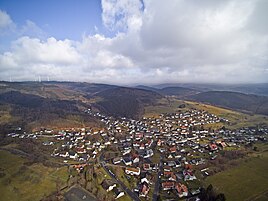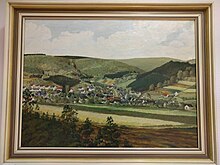Seelbach (Haiger)
|
Seelbach
City of Haiger
|
|
|---|---|
| Coordinates: 50 ° 45 ′ 51 ″ N , 8 ° 10 ′ 40 ″ E | |
| Height : | 321 (290-540) m |
| Area : | 7.9 km² |
| Residents : | 1157 (December 31, 2017) |
| Population density : | 147 inhabitants / km² |
| Postal code : | 35708 |
| Area code : | 02773 |
|
Haiger-Seelbach from above
|
|
Seelbach or Haigerseelbach is a district of Haiger in the Lahn-Dill district in central Hesse .
geography
The place is in the border triangle of Hesse / North Rhine-Westphalia / Rhineland-Palatinate .
The Seelbach district has an area of 789.52 hectares. The high proportion of forest is characteristic of the surrounding area. Particularly noteworthy is the "State Forest Kalteiche", which is located on the Kalteiche (579.3 m). The following message can be found in the village and house book: “In 1901, the community forest of Seelbach was around 145 hectares in size. The state forest Kalteiche lies at an altitude of 430 to 579.3 m with around 283 ha = 23.5% in the community of Seelbach. ”The Treisbach flows through the village .
history
Seelbach was first mentioned historically in a document dated May 2, 1313. In 1327 Heinrich I, Count of Nassau, acquired control of Seelbach by buying it. In 1769 there was a major fire in which the entire village but three houses burned down.
In 1908 the volunteer fire brigade was founded. Before that there was already a compulsory fire brigade. A modern school was inaugurated in 1914, but since 1982 all school children have had to go to Haiger. In 1921 electricity came to Seelbach. In 1971 a new community center was completed after the old multi-purpose church was demolished because of its dilapidation.
In 1957, Seelbach was the state winner in " Our village should be more beautiful ", and in 1981 Seelbach received the bronze plaque in Berlin .
Territorial reform
Until the regional reform in Hesse , the place was a politically independent municipality, which was named Haigerseelbach to distinguish it from other places called Seelbach and in particular Herbornseelbach, which is about 14 km away . The incorporation through the law for the reorganization of the Dill district, the districts of Gießen and Wetzlar and the city of Gießen to Haiger took place on January 1st, 1977. A local district was not established for Seelbach.
Territorial history and administration
The following list gives an overview of the territories in which Seelbach was located and the administrative units to which it was subordinate:
- before 1739: Holy Roman Empire , County / Principality of Nassau-Dillenburg , Haiger Office
- from 1739: Holy Roman Empire, Principality of Nassau-Diez , Haiger Office
- 1806–1813: Grand Duchy of Berg , Department of Sieg , Canton of Dillenburg
- 1813–1815: Principality of Nassau-Orange , Haiger Office
- from 1816: German Confederation , Duchy of Nassau , Dillenburg office
- from 1849: German Confederation, Duchy of Nassau, Herborn district office
- from 1854: German Confederation, Duchy of Nassau, Dillenburg Office
- from 1867: North German Confederation , Kingdom of Prussia , Province of Hessen-Nassau , Administrative Region of Wiesbaden , Dillkreis
- from 1871: German Empire , Kingdom of Prussia, Province of Hessen-Nassau, administrative district of Wiesbaden, Dillkreis
- from 1918: German Empire, Free State of Prussia , Province of Hessen-Nassau, Administrative Region of Wiesbaden, Dillkreis
- from 1932: German Empire, Free State of Prussia, Province of Hesse-Nassau, District of Wiesbaden, District of Dillenburg
- from 1933: German Reich, Free State of Prussia, Province of Hessen-Nassau, Administrative Region of Wiesbaden, Dillkreis
- from 1944: German Empire, Free State of Prussia, Nassau Province , Dill District
- from 1945: American occupation zone , Greater Hesse , Wiesbaden district, Dillkreis
- from 1949: Federal Republic of Germany , State of Hesse , Wiesbaden district, Dillkreis
- from 1968: Federal Republic of Germany, State of Hesse, administrative district Darmstadt , Dillkreis
- On January 1, 1977, Seelbach was incorporated into the town of Haiger as a district.
- from 1977: Federal Republic of Germany, State of Hesse, Darmstadt administrative district, Lahn-Dill district
- from 1981: Federal Republic of Germany, State of Hesse, Gießen administrative district , Lahn-Dill district
population
Population development
| Haigerseelbach: Population from 1834 to 2017 | ||||
|---|---|---|---|---|
| year | Residents | |||
| 1834 | 394 | |||
| 1840 | 418 | |||
| 1846 | 411 | |||
| 1852 | 399 | |||
| 1858 | 400 | |||
| 1864 | 390 | |||
| 1871 | 362 | |||
| 1875 | 360 | |||
| 1885 | 330 | |||
| 1895 | 364 | |||
| 1905 | 383 | |||
| 1910 | 388 | |||
| 1925 | 438 | |||
| 1939 | 469 | |||
| 1946 | 623 | |||
| 1950 | 640 | |||
| 1956 | 633 | |||
| 1961 | 669 | |||
| 1967 | 747 | |||
| 1970 | 836 | |||
| 1985 | ? | |||
| 2005 | 1,270 | |||
| 2008 | 1,248 | |||
| 2017 | 1,157 | |||
| Data source: Historical municipality register for Hesse: The population of the municipalities from 1834 to 1967. Wiesbaden: Hessisches Statistisches Landesamt, 1968. Further sources:; after 1970: City of Haiger | ||||
Religious affiliation
Source: Historical local dictionary
| • 1885: | 260 Protestant (= 78.79%), no Catholic and 70 other (= 21.21%) Christians |
| • 1961: | 586 Protestant (= 87.59%) and 76 Catholic (= 11.36%) residents |
| • 2005: | 752 Protestant (= 59.21%), 112 Catholic (= 8.82%) and 442 other (= 34.80%) residents |
Former mines
coat of arms
The coat of arms of Seelbach shows the bloodroot plant . This symbol can be found on a New Year's iron from 1711. The coat of arms was approved in March 1974 and published in the State Gazette of March 8, 1974: "In blue a golden ring, inside a golden flower."
Culture and sights
Sports club
- SSV 1920 Haigerseelbach eV
The linen museum
The old town hall of the village houses a complete collection on the subject of linen on the first floor . The path from sowing the flax to the finished sewn and ironed piece of laundry is shown. In the attic, the elegant side of the flax is shown, the finest lace made of linen, silk and cotton yarn, handcrafted.
The cheek
The last bakery that was in operation is on the ground floor of the old town hall in the center of the village. Today it is used once a year by the association for village and landscape maintenance at the big Backesfest. There are two ovens here. In the past, the large one was used regularly, while the small one was only used on festive days.
Bronze plaque "Our village should be more beautiful"
In 1982 Seelbach was presented with the bronze plaque for the national competition " Our village should be more beautiful ". Of the 5082 originally participating municipalities in the Federal Republic of Germany, Seelbach was one of the 32 selected winners. In addition, the State Secretary and later Hessian State Development Minister Jörg Jordan awarded the village a large bronze plaque for long-term, successful participation in the village beautification competition. This bronze plaque can still be seen today on Wilhelmsplatz, where it was mounted on a boulder.
Cultural monuments
See the list of cultural monuments in Haiger-Seelbach
Natural monuments
See the list of natural monuments in Haiger-Seelbach
traffic
The easiest way to get to Seelbach is via the BAB 45 (Sauerland line) exit Haiger / Burbach .
Individual evidence
- ↑ Area by district. In: Internet presence. City of Haiger, archived from the original on April 7, 2016 ; accessed in March 2018 .
- ↑ Population statistics . (PDF) In: Internet presence. City of Haiger, archived from the original on March 25, 2018 ; accessed in March 2018 .
- ↑ Law on the restructuring of the Dill district, the districts of Gießen and Wetzlar and the city of Gießen (GVBl. II 330–28) of May 13, 1974 . In: The Hessian Minister of the Interior (ed.): Law and Ordinance Gazette for the State of Hesse . 1974 No. 17 , p. 237 ff ., § 25 ( online at the information system of the Hessian state parliament [PDF; 1,2 MB ]).
- ↑ a b c Haigerseelbach, Lahn-Dill district. Historical local dictionary for Hessen. (As of October 16, 2018). In: Landesgeschichtliches Informationssystem Hessen (LAGIS).
- ^ Michael Rademacher: German administrative history from the unification of the empire in 1871 to the reunification in 1990. State of Hesse. (Online material for the dissertation, Osnabrück 2006).
- ↑ HHStAW inventory 360/187: affiliation of Haiger In: archive information system Hesse (Arcinsys Hessen).
- ↑ a b Population figures 2005. In: Website. City of Haiger, archived from the original ; accessed in February 2019 .
literature
- Kurt Becker: Our fathers - the miners of the Bautenberg mine between Gilsbach and Wilden, Dill and Westerwald , Dillbrecht 1994
- Literature about Seelbach in the Hessian Bibliography
Web links
- Haigerseelbach district. In: Internet presence. City of Haiger
- Haigerseelbach, Lahn-Dill district. Historical local dictionary for Hessen. In: Landesgeschichtliches Informationssystem Hessen (LAGIS).



